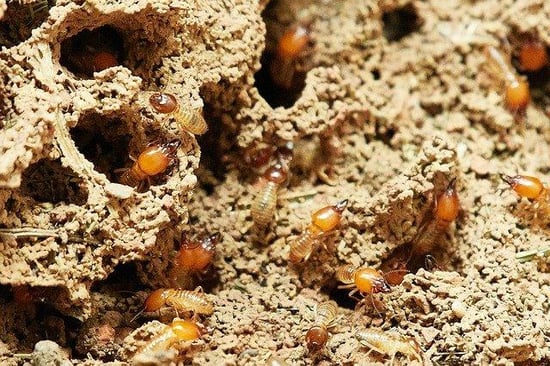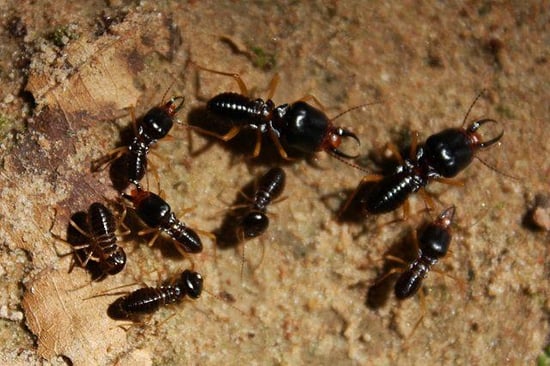Guide to New York Termites - Blog | Thomas Pest
Termites are probably the last insect that you want infesting your home, but the unfortunate truth is that termites are a reality that New Yorkers have to deal with. Understanding which types of termites are common in New York State and how they behave is important, especially when you consider the kinds of problems they can cause for homeowners. This is our guide to New York termites.
Types of Termites in New York
New York is luckily the home of only one type of termite: Subterranean Termites Within this type there are 2 sub-types:
- Eastern Subterranean Termites and;
- Dark Southeastern Subterranean Termites
These two types are largely similar in behavior, but they do have a few differences -- specifically in their times of peak activity and what they look like.
Eastern Subterranean Termites are:
- A creamy translucent color
- Only 1/8 of an inch long
- Blind and soft-bodied
- Active March through May

Dark Southeastern Termites are:
- Around ⅓ of an inch long
- Have dark brown or black bodies
- Have rectangular-shaped heads
- Are active March through June

("Angkor Termites" by Thomas Brown is licensed under CC BY 2.0)
Subterranean Termite Behavior
Like many other species of termite, these creatures live in colonies. This means that if they arrive at your home, they’re going to come in large numbers. They can be categorized as falling into 3 main types, or “castes”: workers, soldiers, and reproductives. These termites feed on all sorts of wood, including the wood from trees in yards and the wood fixtures that make up the structures of homes.
Subterranean termite queens are able to lay up to 2,000 eggs daily, which makes an infestation of these destructive insects a serious problem.
Where Subterranean Termites Live
Subterranean termites are tied to the mud tubes that they construct. Without the safety of these mud tubes, they quickly become dehydrated and die. Because of this dependence on mud tubes, subterranean termites need a ground-level entry point to get into a structure -- but that doesn’t mean that they can’t work their way through any home or building once they’re in.
If a colony gets the opportunity to grow large enough, they can slowly begin to creep their way upward, sometimes colonizing a home or building as far up as multiple stories high. Because exterior walls are the location where the ground and soil most often come into contact, wall voids or spaces inside of walls are most susceptible to termite invasion.
Signs of Subterranean Termites
There are a number of signs that your home is dealing with a subterranean termite problem:
- Presence of mud tubes on the exterior of the home.
- Soft wood in the home that sounds hollow when tapped
- Darkening or blistering of wood structures
- Uneven or bubbling paint.
- Small piles of feces that resemble sawdust near a termite nest.
- Discarded wings near doors or on windowsills.
Damage Subterranean Termites Cause
Once they’re in, termites will start chewing away at whatever wood and cellulose material they can get their teeth on. Termites are conventionally known as wood-eaters, but what they actually go after is cellulose; cellulose is a main component of wood, but it can also be found in other non-wood objects, such as carpeting and sheetrock covering.
How Bad Can Subterranean Termite Damage Get?
So how bad can subterranean termite damage get? According to NC State, a colony containing 60,000 workers can consume the equivalent of one foot of a 2" x 4" piece of lumber in slightly over 5 months. This might not seem like a lot of damage, but termite infestations can last for years without ever being noticed. A years-long termite infestation can cause significant damage.
Subterranean Termite Control in New York
At Thomas Pest Services, we have comprehensive termite control to make your New York home safe and sound -- and termite-free. Here’s how it works:
- Inspection- We examine your home or business inside and out and recommend a solution to your termite problem.
- Installation- Our pest professionals will install our termite elimination system which contains bait to control and monitor subterranean termites in your structure. Termites will quickly discover the bait stations and begin feeding immediately. Once the bait is ingested, termites cannot reproduce which halts the growth of their colony. This termite control method not only kills foraging termites, it eliminates the entire colony, while protecting your structure from termite damage.
- Ongoing Monitoring- We’ll visit regularly and take a proactive approach to detecting termites.
Looking for termite control today? Click here to get started.


.png)
.png)
